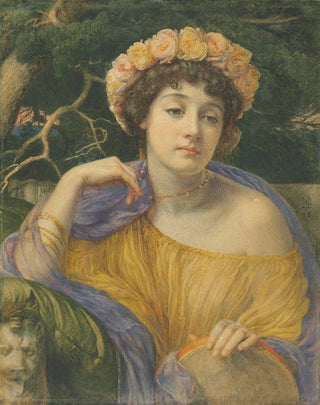Art print | The dancer - Edward John Poynter


View from behind

Frame (optional)
In the fascinating world of art, some works transcend their era and capture the very essence of human beauty. "The Dancer" by Edward John Poynter is one of those creations that, through its elegance and grace, transports us to a world where movement and emotion meet. This iconic piece, created at the end of the 19th century, perfectly illustrates the artist's mastery and skill in capturing fleeting moments, immortalizing dance in all its splendor. By contemplating this work, the viewer is invited to feel the lightness of the ballerina, to vibrate to the rhythm of her dance, and to marvel at the delicacy of her movements.
Style and uniqueness of the work
The uniqueness of "The Dancer" lies in how Poynter manages to blend realism and idealization. Every detail, from the folds of the costume to the expressions on the face, demonstrates meticulous attention to the depiction of the body in motion. The ballerina, frozen in a graceful pose, appears both dynamic and serene, evoking a perfect harmony between body and spirit. The colors chosen by the artist, soft and luminous, help create an almost ethereal atmosphere, where light plays a crucial role. This work does not merely depict a dancer; it evokes a state of mind, a celebration of beauty and the art of dance, while echoing the aesthetic concerns of its time.
The artist and his influence
Edward John Poynter, a prominent figure of the Pre-Raphaelite movement, left his mark on his era with his innovative approach to painting. Trained at the Royal Academy of Arts in London, he was influenced by masters such as Dante Gabriel Rossetti and John Everett Millais, while developing a style that was uniquely his own. His passion for history and mythology is reflected in his works, but it is in "The Dancer" that he manages to capture the very essence of humanity through movement. Poynter also played a crucial role in mentoring many artists, sharing his

Matte finish

View from behind

Frame (optional)
In the fascinating world of art, some works transcend their era and capture the very essence of human beauty. "The Dancer" by Edward John Poynter is one of those creations that, through its elegance and grace, transports us to a world where movement and emotion meet. This iconic piece, created at the end of the 19th century, perfectly illustrates the artist's mastery and skill in capturing fleeting moments, immortalizing dance in all its splendor. By contemplating this work, the viewer is invited to feel the lightness of the ballerina, to vibrate to the rhythm of her dance, and to marvel at the delicacy of her movements.
Style and uniqueness of the work
The uniqueness of "The Dancer" lies in how Poynter manages to blend realism and idealization. Every detail, from the folds of the costume to the expressions on the face, demonstrates meticulous attention to the depiction of the body in motion. The ballerina, frozen in a graceful pose, appears both dynamic and serene, evoking a perfect harmony between body and spirit. The colors chosen by the artist, soft and luminous, help create an almost ethereal atmosphere, where light plays a crucial role. This work does not merely depict a dancer; it evokes a state of mind, a celebration of beauty and the art of dance, while echoing the aesthetic concerns of its time.
The artist and his influence
Edward John Poynter, a prominent figure of the Pre-Raphaelite movement, left his mark on his era with his innovative approach to painting. Trained at the Royal Academy of Arts in London, he was influenced by masters such as Dante Gabriel Rossetti and John Everett Millais, while developing a style that was uniquely his own. His passion for history and mythology is reflected in his works, but it is in "The Dancer" that he manages to capture the very essence of humanity through movement. Poynter also played a crucial role in mentoring many artists, sharing his






